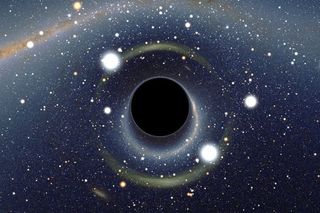
What Would Happen If You Fell into a Black Hole?

Black holes are without question some of the strangest places in the universe. So massive that they hideously deform space and time, so dense that their centers are called "points at infinity," and pitch- black because not even light can escape them, it isn't surprising that so many people wonder what it would be like to visit one.
It's not exactly a restive vacation spot, as it turns out.
If you were to take a step into a black hole, your body would most closely resemble "toothpaste being extruded out of the tube," said Charles Liu, an astrophysicist who works at the American Museum of Natural History's Hayden Planetarium.
Liu said that when an object crosses a black hole's "event horizon" — its outer boundary, or point of no return — the same physics that causes Earth's ocean tides begins to take effect. Gravity's strength decreases with distance, so the moon pulls on the side of the Earth closer to it a bit more vigorously than the side farther from it, and as a result, Earth elongates ever so slightly in the direction of the moon. The land is sturdy, so it doesn't move much, but the water on Earth's surface is fluid, so it flows along the elongated axis. "That's the tidal interaction," he said.
Rising tides are about as calming a scene as there is. A human toeing the line of a black hole? Not so much. [What's at the Center of a Black Hole?]
Near a black hole roughly the size of Earth, tidal forces are magnified off the scale. Swan-diving into one, the top of your head would feel so much more gravitational pull than the tips of your toes that you would be stretched, longer and longer. "[The British astrophysicist] Sir Martin Rees coined the term 'spaghettification,' which is a perfectly good way to put it. You eventually become a stream of subatomic particles that swirl into the black hole," Liu told Life's Little Mysteries.
Because your brain would dissociate into its constituent atoms almost instantly, you'd have little opportunity to soak in the scenery at the threshold of an Earth-size black hole.
Sign up for the Live Science daily newsletter now
Get the world’s most fascinating discoveries delivered straight to your inbox.
However, if you're dead-set on visiting a space-time singularity, we recommend going big; bigger black holes have less extreme surfaces. "If you had a black hole the size of our solar system, then the tidal forces at the event horizon … are not quite that strong. So you could actually maintain your structural integrity," Liu said.
In that case, you would get to experience the effects of the curvature of space-time, predicted by Einstein's general theory of relativity, firsthand.
"First of all, you approach the speed of light as you fall into the black hole. So the faster you move through space, the slower you move through time," he said. "Furthermore, as you fall, there are things that have been falling in front of you that have experienced an even greater 'time dilation' than you have. So if you're able to look forward toward the black hole, you see every object that has fallen into it in the past. And then if you look backwards, you'll be able to see everything that will ever fall into the black hole behind you.
"So the upshot is, you'll get to see the entire history of that spot in the universe simultaneously," he said, "from the Big Bang all the way into the distant future."
Not such a bad way to go, in the grand scheme of things.
Follow Natalie Wolchover on Twitter @nattyover. Follow Life's Little Mysteries on Twitter @llmysteries, then join us on Facebook.
Natalie Wolchover was a staff writer for Live Science from 2010 to 2012 and is currently a senior physics writer and editor for Quanta Magazine. She holds a bachelor's degree in physics from Tufts University and has studied physics at the University of California, Berkeley. Along with the staff of Quanta, Wolchover won the 2022 Pulitzer Prize for explanatory writing for her work on the building of the James Webb Space Telescope. Her work has also appeared in the The Best American Science and Nature Writing and The Best Writing on Mathematics, Nature, The New Yorker and Popular Science. She was the 2016 winner of the Evert Clark/Seth Payne Award, an annual prize for young science journalists, as well as the winner of the 2017 Science Communication Award for the American Institute of Physics.
Most Popular


